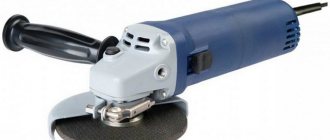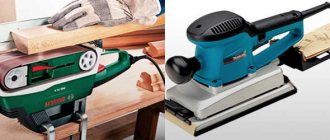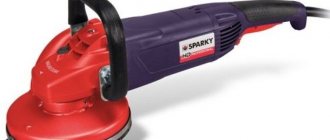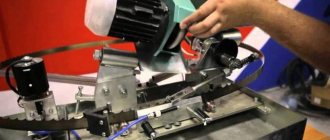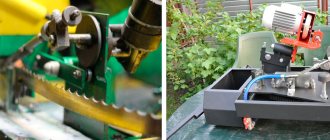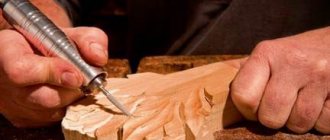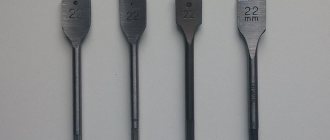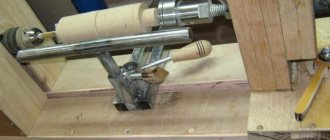Articles
All photos from the article
In carpentry, the final stage can be considered to be grinding the surface of the workpiece; only after this can paint and varnish materials be applied. If the surface of the product is smooth and not curved, then to increase the processing speed it is best to use grinding machines.
Sander in action
Factors to consider
If you need to process a wooden surface, then you need to choose the optimal device to do it correctly; you should take into account several important criteria:
| Type of product being processed | It can be anything: load-bearing elements made of timber or logs, finishing made of lining, block house or boards, window and door blocks, furniture elements, decorative items and much more. Naturally, each type of product has its own optimal tool option, with which you can achieve the best quality of work with the least amount of time and effort. |
| Sanding quality | Another important factor, because in some situations it is necessary to smooth out large irregularities, and in others it is necessary to bring the surface to an ideal state. Therefore, before sanding wood, you need to stock up on the necessary consumables - discs or brushes with different grain sizes. |
| Scope of work | Smaller projects can be handled by hand, while larger projects will require the use of power tools, otherwise they can take weeks or even months to complete. If you decide to sand the wood yourself, the easiest way is to rent the necessary equipment; the price of this service is low. |
For large volumes of work, you will need a sanding cup for wood - its service life exceeds all other options tens of times
The best “Giraffe” grinding machines for premium walls and ceilings
Among the premium-class Giraffe grinding machines, we can highlight the Mirko Leros 950cv model. This option has the highest rotation speed (of those presented in the list of grinding machines). In addition, this model stands out for its excellent quality. Mirko Leros will be a wonderful tool for renovation work in an apartment or during the construction of large objects.
Grinding machine Mirko Leros 950cv
Video – Grinding machine MIRKA LEROS
Random orbital sanders
Eccentric sanders
When processing a wooden surface, the sole of the eccentric sander moves in several directions: back and forth and around its axis. The quality of processing depends on the rotation speed and vibration amplitude. This type of equipment does an excellent job of grinding both smooth surfaces and curved parts. An eccentric sander can be used for fine sanding, polishing and cleaning of wooden parts.
You can use eccentric sanders at home and in professional activities, it all depends on the amplitude of the equipment’s vibrations, the power and the number of revolutions of the grinding surface. The most powerful machines: the vibration amplitude of the processing sole is not less than 7 mm and the power is 750 W, suitable for rough processing and characterized by high productivity.
Eccentric (or orbital) sanders, due to their circular motion path, allow you to achieve a perfectly flat and smooth surface.
Based on the method of attaching sanding sheets, machines are divided into two types: clamping and Velcro models. Machines equipped with a clip are slightly less expensive than similar models with Velcro. This is due to the fact that consumables for this type of equipment are easier to select and cost less. But changing the sanding sheet takes a little longer and is technically more difficult. Machines equipped with Velcro are much easier to use, but consumables are more expensive due to specific fasteners.
Professional and some household models of eccentric sanders are equipped with additional devices for dust removal: vacuum cleaners with dust collectors and a filtration system. Thanks to this, working with equipment becomes safer, since fine dispersed dust is very dangerous for the respiratory system.
General recommendations for selection
The market is flooded with offers from little-known companies; in appearance, such models may not differ much from high-quality devices, but the difference will become noticeable only after some time. The price of such mechanisms may look attractive, but the savings will cost dearly in the future. So you need to know what to look for when choosing such mechanisms.
It is more convenient to give recommendations for choosing a specific model depending on its type, but you can also give some general advice.
In the store it is worth checking out:
- sander weight. It’s good if you don’t need to keep it suspended for a long time, in which case the weight of the machine can even be considered an advantage. But if you have to hold it in your hands, then preference should be given to a higher speed of movement of the working surface;
- its behavior when turned on. It is clear that a wood sander is not a quiet tool, but some models simply set a record, stunning their owners. Also, at idle, it is worth assessing the vibration; if the machine “hits” hard, then there is a high probability of its rapid failure;
- cost – it is quite possible to choose the optimal price/quality ratio without high expenses. The same Interskol produces a fairly reliable tool;
- the possibility of quick repairs also plays an important role, so exotics from this point of view are not the best choice; spare parts for not very common brands of mechanisms are difficult to find;
- The dimensions of the slab, mini-slab (about 100 mm2) are suitable only for processing small wooden products.
Slab dimensions can vary greatly
Some craftsmen make something like grinders on their own. But a homemade machine is not able to compete with professional ones in terms of surface quality. The maximum that such a handicraft mechanism can be used for is processing small wooden parts.
Making a grinder from a grinder
Many may say that the “grinder” is the same as an angle grinder, but there are some subtleties hidden here. It should be borne in mind that the angle grinder has very high speeds and often quite a decent weight. To polish a surface with a grinder, you need to have considerable experience in this matter and use special polishing discs and circles. The grinder has much lower engine speed and weight. To operate a factory grinding machine, no specific experience or skill is required.
You can independently make a good grinder from an angle grinder, which is not inferior in its parameters to a factory machine, only by modifying its electrical circuit, by installing the regulator at lower speeds and by using special grinding attachments.
What is a sander?
For the convenience of processing internal and external surfaces of wood, plastic, metal or stone, a special grinding machine is used. This power tool is designed to make the product smooth, that is, to reduce the roughness coefficient of its surface. The device is actively used in the process of car body repair, construction work, wall and floor repair, and furniture restoration. A grinding machine significantly speeds up manual labor and improves the quality of the work performed.
The best mid-budget “Giraffe” sanding machines for walls and ceilings
For buyers with an average budget, it is recommended to choose the EIBENSTOCKELS 225 model. It will be an excellent assistant for sanding on construction sites and will help out during long-term work. This option is suitable for large volumes, but sometimes additional purchase of the necessary equipment may be required.
Sanding machine EIBENSTOCKELS 225
Video – Sanding machine for walls and ceilings ELS 225 EIBENSTOCK
What is sandpaper
Sanding paper is a combined material that consists of:
- The basis of sandpaper is most often paper or fabric.
- Abrasive is a grain that is applied to a substrate using glue or resin.
Manufacturing
Sandpaper production was first started in China in the 13th century. Craftsmen glued river sand of various sizes, crushed shell rock, and plant seeds to parchment using agar-agar or starch glue. Later they came up with the idea of using crushed glass as an abrasive, hence the appearance of “glass paper.”
Serial production of sandpaper began in London in 1833, then began to spread throughout the world, technology improved, and today we see a variety of types of this product.
Production stages:
- The paper base or fabric is impregnated with polymers, most often rubber latex.
- Glue heated to 30...50C is applied to the prepared base.
- The abrasive of the required fraction is applied using the bulk method.
- The semi-finished product is sent to the oven for drying. The temperature depends on the type of glue, grain fraction and other factors.
In this way, you can make low-quality sandpaper at home using thick cardboard, crumbs from an abrasive wheel or crushed glass, sand.
Release form
Finished products are stored by stacking sheets or rolling them into rolls. Sheet fabrics have sufficient rigidity, so they are difficult to bend. Sandpaper in rolls is more compact to store, its fraction and grain size are smaller than that of sheet sandpaper.
Other release forms:
- The abrasive mesh is a sparse sheet with fixed grain. When sanding, even the smallest dust particles pass through the material and do not become clogged in the pores. This working method is called “dust-free sanding”.
- Abrasive wheels are fine-grained sandpaper cut to the shape of attachments for mechanical devices. Its purpose is to clean the metal surface from rust and remove old coating.
- Sandpaper of different grits, cut to the shape of the attachment for power tools with Velcro fastening or to the holes made.
- Sanding belts intended for threading into sanding machines and machines.
Marking
Sandpaper markings indicate the fraction and concentration of the abrasive. Domestic GOST 3647-80 determines the number of grains of different sizes per 1 square unit, but this classification is considered outdated. Today, sanding paper complies with international ISO standards; this designation can be found on the back of the product. It should be noted that the data of the old GOST and the values of international standards overlap with each other. Their correspondence can be seen in the table.
The main difference between the old and new standards is the different movement of numbers in the markings:
- In GOST 3647-80, the values of grain size and density are reduced, which is quite logical;
- In the new ISO 6344 standard (GOST 52318-2005), the product number increases with decreasing value in the marking.
Decoding grain size
The letter "P" in the designation indicates the grain size. The larger the value behind the letter, the finer the skin fraction. P400 is a known zero. P600...P2500 have small fractions and an almost smooth surface; their grain size is not so noticeable to the touch. This type of sandpaper is used for final polishing in industry.
In the old GOST, things were different. Using 10-N as an example: the first number means that an abrasive of a size corresponding to a sieve with a mesh of 100 microns is applied to the surface of the product. The lower the indicator, the smaller the screening size.
Other designations
Types of sandpaper differ in the composition of the base and the properties of the grains. This information is also reflected in the product labeling.
- The letter “L” indicates the sheet form of the product. Rolled is not indicated in any way.
- The letter "M" stands for waterproof sandpaper.
- The product marked “P” is intended for grinding dry products without contact with moisture.
- “1” is an abrasive for soft surfaces, “2” is for hard surfaces.
To select emery for a certain type of work, you should take into account not only the main classification, but also the information provided, which is contained on the back of the sheet.
What to look for when choosing
In addition to the type of grinder, it is necessary to take into account basic technical parameters:
- Electricity consumption: from 110 to 600 W. It's worth noting that more efficient machines tend to use more electricity. For home, a 300 W option is suitable.
- The number of revolutions the sole makes: 6-25 thousand. Most often, slow instruments have high amplitude. Such models are used for rough processing. For finishing sanding, it is better to choose an electrical appliance with a higher speed.
- Amplitude: 1.5-5 mm. Shows how much the sole moves relative to the material with each movement. If you need a device for rough work, you should choose a device with the maximum value, and for fine finishing 1.5 -2.5 mm is suitable.
Which grinder is better to buy?
For a full cycle of processing wooden surfaces, several grinding machines may be needed:
- For roughing - to remove large irregularities, burrs after sawing or remnants of old paintwork on a large surface - a belt sander with adjustable speed and a belt width of 75-100 mm.
- If the dimensions of the workpiece are small and the surface does not have serious flaws, it will be more convenient to use a surface grinding model with an oscillation amplitude of about 2 mm.
- For finishing grinding and polishing, and working with curved surfaces, you only need an eccentric machine of medium power, capable of producing at least 5000 vibrations per minute.
There are also more narrowly focused tools, such as brush or delta grinders. But only professional craftsmen and carpenters will need them.
| Our choice | Bosch PBS 75 AE | Einhell TE-OS 2520 E | Worx WX820 | DeWALT DWE6423 | Makita 9741 |
| Type | tape | vibration | delta | eccentric | brushed |
| Tool size | 75x533 mm | 115x230 mm | 90x187 mm | 125 mm | 120-129 mm |
| Power | 750 W | 250 W | 20 V | 280 W | 860 W |
| Speed | 350 rpm | 24,000 kol./min | 10,000 kol./min | 12,000 rpm | 3,500 rpm |
| Platform progress | — | 2 mm | 2.5 mm | 2.4 mm | — |
| Dust collector | included | included | included | included | connectivity |
| Button lock | Yes | Yes | Yes | Yes | Yes |
| Add. possibilities | speed adjustment | universal mount | replaceable soles | speed stabilization | second handle |
| Weight | 3.5 kg | 2.3 kg | 2 kg | 1.28 kg | 4.2 kg |
Best in the household series
Despite the shorter service life, the household series tool can process flat and curved surfaces. Perform rough and fine grinding of concrete, plaster, putty. Polish metal, plastic, glass, natural and artificial stone
KOLNER KRS 430 – the cheapest in its segment
The eccentric machine is used on wood, metal and plastic surfaces. Used for leveling plastered walls during home renovations. Polishes varnish and enamel coatings. Smooth speed control determines the required processing mode. Equipped with a dust removal system, which allows operations to be carried out indoors.
PROS
- Affordable price.
- Power.
- Low noise.
- Autonomous dust collector.
MINUSES
Does not perform fine polishing of the car body.
PATRIOT OS-125 – the lightest
The grinder will perform the stages of rough and fine processing of flat and curved surfaces. The low weight of the tool allows you to spend more time working without fatigue during the processing of a part. An effective dust extraction system concentrates waste into a removable dust container. The abrasive wheels are fixed with Velcro, which ensures a quick change of consumables.
PROS
- Lightweight - the hand does not get tired longer.
- Optimal power for home repairs.
- Effective cooling system - the electric motor does not overheat.
MINUSES
You have to hold the machine tighter - centrifugal forces tend to tear it out of your hands during the working process.
ENKOR MSHE-450/150E – the largest fluctuations
Works effectively during rough and medium grinding operations. Levels the plastered surface and smoothes the finishing putty. Removes old paintwork, rust, and scale from metal workpieces. The presence of an additional handle makes it easier to use.
PROS
- Increased diameter of the work plate.
- Long cord.
- Endurance.
MINUSES
- Ineffective dust collection system.
- The fixation of the sanding attachments fails quite quickly.
BOSCH PEX 300AE – the most productive
Tool for household use. Despite the classification, it allows dry sanding of wood, metal, and plastic. It is used for home repairs to remove old paint coatings, leveling plaster and putty. Dust emissions are mitigated by an effective microfiltration system.
PROS
- Allows you to perform a large amount of work.
- Doesn't get dusty.
- Equipped with an anti-vibration system.
MINUSES
- A bit noisy.
- Abrasive discs do not work evenly over the area.
ELITECH MSHE 0515E – the most powerful
The power of the electric motor is sufficient to perform operations such as grinding down convexities of plastered walls, smoothing the putty layer, and grinding the surface of ferrous and non-ferrous metals. Performs rough and finishing processing of wooden blanks. Connecting a vacuum cleaner allows you to keep your work area clean.
PROS
- Powerful electric motor.
- Work at a semi-professional level.
- Long cable.
MINUSES
An extra handle is missing.
Application of belt sanders
Belt sanders are used where it is necessary to quickly remove a fairly thick layer of material, for example, to sand an unplaned board or remove old paint from surfaces. LSMs are also used for precise fitting of parts and processing of the cut line.
The material is processed using an abrasive belt closed in a ring and stretched over rotating rollers. When moving, the tape removes a fairly thick layer of material, comparable to the work of an electric planer. The thickness of the removed layer depends on the grain of the abrasive belt.
When choosing a blade grinder, you need to pay attention to two parameters: the width and length of the abrasive belt used and its rotation speed. The area of the processed surface depends on the width, the aggressiveness and degree of processing depends on the speed.
The standard tape sizes for LSM are: 76x457 mm, 76x533 mm, 76x610 mm. The belt width of semi-professional sanders may be larger - 100 mm, but they are rarely used for household needs. The belt speed is usually in the range from 150 to 500 meters per minute, the power is from 400 to 1200 W. Useful functions include smooth control of the belt rotation speed and an automatic belt centering device, which prevents it from slipping off the rollers even during rotational movements.
Belt sander for wood
There are two types of abrasive belt for blades, with an abrasive layer of aluminum oxide or zirconium. Zirconium tape provides a deeper but more aggressive finish and promotes scratches that need to be treated with a less grainy tape. For processing metal surfaces, it is better to choose a zirconium tape; it can be used to sharpen cutting surfaces.
Surface processing using a belt sander is carried out as follows: place the machine on the surface to be processed without distortions, and, without putting pressure on the machine, make smooth longitudinal or circular movements along the surface of the material. If precise fitting of parts is necessary, grinding is carried out with short-term translational movements or using a bounding frame.
The use of eccentric (orbital) sanders
Orbital sanders are similar in principle to rectangular orbital sanders, but are distinguished by greater productivity and a finer degree of grinding and polishing due to the complex oscillation path. Surface treatment is carried out with a grinding disc with a diameter of up to 150 mm; special sanding wheels with different grain sizes or grinding felt attachments are used as an abrasive attachment.
The power of orbital sanders is usually 200-650 W, the speed is up to 13,000 per minute, the eccentric oscillation speed is up to 24,000 per minute. Regulating the number of revolutions and oscillations, as well as adjusting the amplitude of the eccentric, like the VSM, are very useful functions.
Using orbital sanders
All grinding machines are characterized by the formation of large amounts of dust during operation. Some models are equipped with holes in the sole for collecting dust and a dust collector. This option is very useful when working indoors, so if possible, you should pay attention to models with dust collection. Also important is the length of the cord - if the cord is short, you will have to constantly use an extension cord. You can also choose a cordless sander. When purchasing, you should pay attention to the shape of the handle and the weight of the tool, holding it in your hands for some time, trying out the inclusion and regulation of modes.
Kinds
Before choosing a wood sander, you need to familiarize yourself with the main types of devices.
Tape
It is recommended to buy such carpentry sanders for the first sanding of wooden surfaces. They are ideal for removing old layers of varnish or paint. Also, tape devices are often used to fit furniture parts.
Belt-type tools work on the principle of a plane. The circle-shaped tape rotates on special rollers. To start the sanding process, you need to press on it with a wooden product.
Orbital (palm)
When choosing a sander, you may encounter orbital devices. They can be divided into two main types.
Standard
Tape devices - most common models
It is recommended to buy such grinding machines for people who often have to work with uneven surfaces. Standard orbital models are suitable for processing sharp corners and flattened edges of wood.
These devices resemble tape devices. The only major difference is that grain paper is used instead of ribbons. Compared to belt sanders, orbital sanders are more versatile and multifunctional. Some consider them to be the best devices for sanding wood.
Random orbital
Another device that is often used for processing wooden products is random orbital CMMs. They differ from other models in the features of their work. Sanding is carried out using the installed sandpaper. It not only moves with the help of rollers, but also vibrates a little. Thanks to this, it is possible to clean even ribbed surfaces.
Detailed and multi-tooled
The best wood sanders include detail and multi-tool products. There are several varieties of such models.
File Sander
File Sander - universal polishing machine for polishing various materials
Quite often people hear the terms “finger sander” and “sander”, but do not know their exact meaning. These phrases are used to describe grinders that are equipped with a very narrow belt. With its help, it is possible to process even hard-to-reach places that cannot be reached using conventional CMM.
Such models are universal, as they can be used for sanding coatings made of:
- metal;
- wood;
- plastic;
- ceramics.
To process the above materials, you will have to use paper of different grain sizes.
Oscillating spindle
Oscillating spindles are often found in the ratings of grinding machines. This is a static tool that is equipped with a fairly long grinding drum.
Such CMM models are often used as tabletop tools. They are used for processing difficult angles, as well as curved surfaces. At the same time, the oscillating spindle is capable of sanding not only wood, but also metal.
Sander straight
Drum CMMs will help clean wood from glue, paint or varnish
Many people don't know which sander is best for smoothing straight edges. For such purposes, it is necessary to choose a straight sander. This tool will quickly smooth out all the edges and polish your plank floors or walls.
The main difference between this tool can be considered the features of its operation. During sanding, the sandpaper moves parallel to the grain. Thanks to this, it is possible to polish the edges of products much better. It also makes sanding ribbed surfaces easier.
Drum type sander
People are often interested in which sander is best for sanding wooden floors. A fairly popular tool that is regularly used in woodworking is the drum-type CMM. This device can be used to remove residual glue, paint or varnish. Also, with the help of such an angle grinder you can process surfaces made of plastic, metal and ceramics.
Wood brushing machine
Brushing is a method of artificially aging wood, which involves the use of specialized tools and techniques. The brushing technique is based on the mechanical processing of wood with special metal brushes, with the help of which the softest upper fibers of the material are removed.
Thanks to this technique, the hard surface of the wood is exposed, on which the texture of the material and the structure of the growth rings are clearly visible, and a beautiful relief is formed, emphasizing the aesthetic appearance of the finishing material. However, the brushing process does not end there.
To emphasize the relief and make the structure of the wood even more distinct, it is highlighted with a color that gives richness to natural shades.
To do this, the surface treated with a metal brush is unevenly painted, while the depressions formed as a result of the removal of soft fibers are painted in darker shades, and the surface texture is painted in lighter shades. Thanks to this technique, the wood relief becomes as noticeable as possible.
Important! In order for artificially aged wood to acquire maximum resemblance to a material that has aged in a natural environment, experts recommend painting the previously brushed material gray. Without waiting for the paint to dry completely, it is smeared from the relief surface.
The artificial structuring method can be used in the processing of both hard and soft wood. The main requirement that wood to be brushed must meet is the presence of a clearly defined texture and clearly visible layers of varying hardness.
Such materials include oak, pine, walnut, larch, wenge and ash.
As for alder, cherry, birch, teak, maple and beech, the brushing method will be proven to be ineffective for these species, since the distinctive feature of these trees is a fine-fiber structure without pronounced layering.
On a production scale, the amount of work is many times higher, and therefore there is a need to automate the process, which involves the use of special machines.
This helps simplify the work of producing aged wood, and also reduces time costs, allowing large volumes of work to be completed in a short period of time.
If you want to purchase special machines for brushing wood at home, it only makes sense if you plan to do a large amount of work. Let's look at the most common models of stitching machines.
Cleaning router or so-called brushing machine for brushing wood FESTOOL RUSTOFIX RAS 180.
- Three brushes are supplied with this device:
- The first steel wire brush used for primary wood processing;
- Second synthetic bristle brush for intermediate sanding;
- The third, made of sisal, is used to polish the treated surface.
The Makita 974 sander can also be used for sanding wood, however, while working with it, difficulties may arise associated with processing corner areas.
In this regard, at the joints between walls and floors, it is necessary to additionally use an angle grinder equipped with attachments.
The Felisatti AGF 110/1010E grinder can be used to process both relatively smooth and uneven surfaces. Metal and nylon brushes are supplied with this device.
It has an analogue - the Interskol sanding machine, which will make sanding wood much easier if you follow the instructions presented in our article.
Main settings
Before choosing a tool, you need to understand its main characteristics.
- Power. The performance of the grinder depends on this parameter. The power of this tool ranges from 600 to 2500 W. The greater the power of the unit, the higher its quality indicators. They weigh more and cost an order of magnitude more. For simple woodworking, a grinding machine with a power rating of 600-800 W is suitable.
- Working surface area. This value affects the speed of work. The larger the working surface area, the faster it will be possible to grind the desired plane. Belt options have a smaller working surface, while vibrating ones have a larger one.
- Disc diameter. The diameter determines the area that can be processed at one time. This parameter also affects the finishing time.
- Additional equipment. Different models can be equipped with additional auxiliary elements.
- Additional handle. The handle helps to evenly distribute the load and reduce vibration. They are mostly two-position, less often three-position.
- Dust collector. Collects dust that is generated during operation of the mechanism. It can be either built into the unit itself or be a removable element on the side. There are replaceable and permanent options for dust collectors.
- Speed stabilizer. It can be used to control the rotation speed. The stabilizer allows optimal use of the grinding machine's performance.
- Speed controller. With its help, you can control and regulate the speed required for work.
- Case. A convenient way to store and transport tools.
- Battery. For autonomous use of the grinder, some models are equipped with a removable battery.
What is sanding?
Grinding as a process does not evoke the most pleasant impressions for many, even when just mentioned. What can I say – this is a monotonous, painstaking, time-consuming, and slightly harmful operation, but it cannot be avoided. Modern requirements for finishing work have increased so much that no one questions that the surfaces must be perfectly smooth.
Manufacturers of finishing coatings try to make sure that only one layer is needed, which will smooth out all the imperfections of the base. Even sheets with a decorative coating need to be joined together, which entails filling with putty and, inevitably, sanding. Builders and finishers in our country are slowly but surely beginning to master all the newly introduced standards and techniques for achieving them.
Fortunately, progress is not lagging behind: such a useful and inexpensive tool as a grinding machine helps to cope with this task. The hated sandpaper for grouting, or the timber clutched in your hands, remains a thing of the past. Equipment manufacturers spoil us with a variety of tools that are designed for many types of repair work, and sometimes it is difficult to choose the tool that is right for you. So how to choose a grinder? It’s not difficult to deal with this issue; the main thing is to understand why this or that tool is needed, and to understand what exactly you want to get as a result.
How to cut a coffee grinder?
On the Internet, this topic is so “hackneyed” that you can get confused in the advice of “masters” on how to work with an angle machine correctly and safely: for yourself or for yourself?
This is because there are no generally accepted standards (scientifically validated by government experts) that are suitable for all types of work. Therefore, each experienced master confirms or denies different methods. As they say: there are as many people as there are opinions.
To avoid bad consequences, we will try to tell you the correct method based on the safety concepts and operating principles of angle grinders.
I’ll say right away that you can work for yourself or independently, both options will be correct if they are technically and safely observed.
On all grinding machines the spindle rotates clockwise.
- When we take the tool with our right hand and with our left hand by the additional handle, the disk rotates in our direction, which is called “toward ourselves.” In this case, you need to cut the coffee grinder yourself. Sparks will fly to the ground when the angle grinder is on its side. With this cut, the saw does not cling to the cutting edge, so it will not bite, clog or break.
- By moving the additional handle to the lower position, you, on the contrary, will work with a sander. The cutting blade will be facing in the opposite direction from you, making an “away from you” motion. This sawing technique is less convenient because you have to bend over to see the markings. Another feature of cutting on your own with a sander is that the movement of the tool will occur towards you. The sparks will be directed in the opposite direction. This method is mainly used by left-handed people.
Any of these methods of working with a sander is correct. Main
take precautions, do not cut the material against the “wool”
How to cut metal?
Metal is cut according to the principle described above
Let's explain some features to pay attention to:
- Sheet metal up to 3 mm. It can handle grinding machine power up to 1 kW and disc diameter 115-125 mm. On a thin surface, the wheel wears out faster due to the vibration of this material. To avoid this, place an extra board on the cutting line.
- For thicknesses from 3 mm, the grinding machine is more powerful and has a larger wheel diameter. You don't need to press the tool while cutting, the high speed will do everything for you. When working with a 250 mm diameter blade on thick workpieces, be careful not to twist it. Otherwise, you will get a curved section and a rupture disk.
Always ensure that the work piece or pipe does not pinch the saw. You must know exactly what will happen in the first second after you start cutting.
How to cut concrete and stone?
It is difficult to cut concrete, stone and brick because the cut is almost invisible due to the dust.
READ How to Use a Wood Sander
The first 10 cm will need to be cut blindly. Then, without turning off the sander, remove it from the cut and look at where the cut went.
Apply the included grinder to the cut, adjusting it to the cutting line. We look at the verticality of the disk and slowly draw it in the air above the cut line. If the sander is not warped, lower it to the edge of the cut and sink it slowly. The dust column forms again, so we continue to move “blindly” along the required mowing line, adhering to verticality and the desired angle. The deeper the cut, the tighter the machine should be sharpened.
If you do it right, you will feel the wedge before you hit. And you can even stop the impact by turning off the power and holding the crusher in the cut.
How to cut tiles?
Cutting tiles without chips is carried out using abrasive discs for stone. A diamond blade will cut faster, but will hit a lot. Can be used where a small incision is not required.
You need to cut the tiles using constant back and forth movements. You don't have to stay in one place (as you would when cutting metal or concrete) to prevent the tiles from melting and cracking.
Good tile cut. This is the correct choice of nozzle and precision in work. You can even cut hard floor tiles with an abrasive stone blade without chipping.
How to choose the right one based on your needs
Any hand-held electric tool has criteria that determine the parameters for its selection. For grinding machines, the general selection criteria are:
- Electrical power – the performance of the tool depends on it.
- The method of connection to the energy source (cord, battery), and if there is a cord, its length.
- Ease of use - depends on the type of materials used and finishing elements (rubber handles, handles, etc.), as well as the location of the handles on the product body.
- The weight of the tool – the mode of use depends on it, as well as the ability to work “in weight”.
- Availability of automation and protection systems - soft start and protection against short circuit currents.
- Possibility of adjusting speed modes - drive speed and abrasive tool speed.
- Possibility of connecting to a vacuum cleaner or dust storage container.
Using belt-type machines for grinding workpieces
When choosing belt-type models, in addition to the above criteria, you should pay attention to:
- length and width of the tape;
- type of belt centering mechanism (manual or automatic);
- presence of a brake;
- shape and the presence of an additional handle for ease of use.
When choosing orbital-type models, you need to pay attention to the following nuances:
- sole diameter;
- eccentricity value;
- presence of braking function.
Variety of types of wood sanders
When choosing vibration devices, you should pay attention to:
- shape and size of the sole;
- method of fastening the abrasive material;
- amplitude of the sole stroke.
Read more about choosing and using a sander
Each of these types of sanders has its own characteristics, so when considering the question of which wood sander to choose, this must be taken into account.
Belt sanders
The power range of such devices ranges from 0.5-1.2 kW, and the belt speed is 100-150 m/min (depending on the manufacturer, simpler models have a lower speed limit of 150 m/min).
Note! Little-known manufacturers (especially from China) like to overestimate engine power. So, by succumbing to the magic of marketers, you can end up with a much less powerful device than you need.
When choosing hand-held wood sanders, the speed/power ratio is of particular importance. You can often find tools with high belt speed, but low power. This is done in order to minimize the risk of damage to the wooden surface, and it will be much easier to operate such a sander.
Speed control switch
Models with the ability to set a specific speed limit can be considered an ideal choice. If you need a universal option, then you can pay attention to slower models. If all the work is done with your own hands, then you can simply press the machine a little harder.
Additional nice touches include a dust collection bag (or a hole for connecting a vacuum cleaner), as well as devices for fixing the tool in place, turning it into a stationary one. The kit may also include special stops so that the machine can be moved along a straight or inclined line.
The photo shows a dust bag
There are a couple more little things that need to be taken into account when solving the problem of how to choose a belt sander for wood. The diameter of the front roller should be as small as possible, this will allow the surface to be processed with a minimum blind area. Also, some manufacturers make the roller barrel-shaped, which allows the belt to self-center.
Small diameter front roller expands tool capabilities
Choosing an eccentric and vibration machine
When choosing, pay attention to the following parameters:
- power, for modern mechanisms it is in the range of 200 - 900 W;
- the device must be equipped with an electrodynamic brake, which, after turning off the power, should instantly stop the oscillations of the plate. It is advisable to check this at idle speed;
Random orbital sander
- If you need a powerful tool, then the choice of a wood sander may be influenced by the presence of a starting current limiter. This allows you to avoid short-term network overloads and jerking of the plate during startup;
- the amplitude of the eccentric is in the range of 2-7 mm, and the rotation speed is 4-14 thousand;
- such devices can be equipped with elastic plates for processing curved surfaces;
Due to the elastic plate, curved surfaces can be processed
- Also, when choosing, it is better to focus on medium and small sized plates. Let the processing speed be a little slower, but there will also be fewer blind corners.
As for how to choose a vibration-type wood sander, you need to consider:
- Such devices have the minimum power among all listed; the power of most devices is in the range of 150 - 300 W. But there are exceptions - powerful professional grinders can be equipped with a 600-watt motor;
In the photo - a vibrating grinder
- a high-quality device should practically not vibrate at idle;
- vibration amplitude from 1-3 mm to 5-6 mm depending on the model;
- The type of sandpaper fixation is also important. Both the Velcro option and special spring-loaded clamps can be used.
It is impossible to give a definite answer to the question of which sanding machine is best for wood; it all depends on your goals.
Basic rules for working with the tool
At first glance, it may seem that using wood sanders is simple and anyone can cope with this task.
This is only partly true; in order for the machine to last a long time and the quality of processing to be beyond praise, it would not be amiss to consider the question of how to use a wood sander:
- before connecting to the network, you need to make sure that the power button is not in the “on” position;
- There is no need to press hard on the device. If a horizontal surface is being processed, then the device’s own weight is usually sufficient; in addition, with strong pressure, a high load is created on the motor, which reduces its service life;
There is no need to press hard, just hold the device with your hand.
- the device should be moved along the surface being treated at a constant speed; there is no need to rush;
- you need to understand that the tape does not last forever, so it is periodically cleaned of dust and replaced if necessary;
- if you need to process a small wooden part, then it is better to fix the sander itself and bring the wooden part to the plate;
- The operating instructions also require the use of personal protective equipment (gloves, goggles, respirator).
Personal protective equipment is essential
Delta grinding
This is the same eccentric machine, but it looks like an iron. Just like in VSM, here, with the help of oscillatory movements, material is “selected” from the workpiece being processed. Almost all DShMs are equipped with dust collectors or connectors for connecting a vacuum cleaner. This Metabo FMS 200 can fit into any corner.
Delta sanders or renovators are designed for grinding and polishing hard-to-reach areas, such as internal corners or edges of complex profiles. This Metabo FMS 200 can fit into any corner.
This machine is also convenient for processing areas after decorative cutting of wooden furniture structures with a milling machine. This is a fairly highly specialized tool that is worth buying only if you often need to work corners. For the most part, VSM replaces this polishing “iron” quite well.
